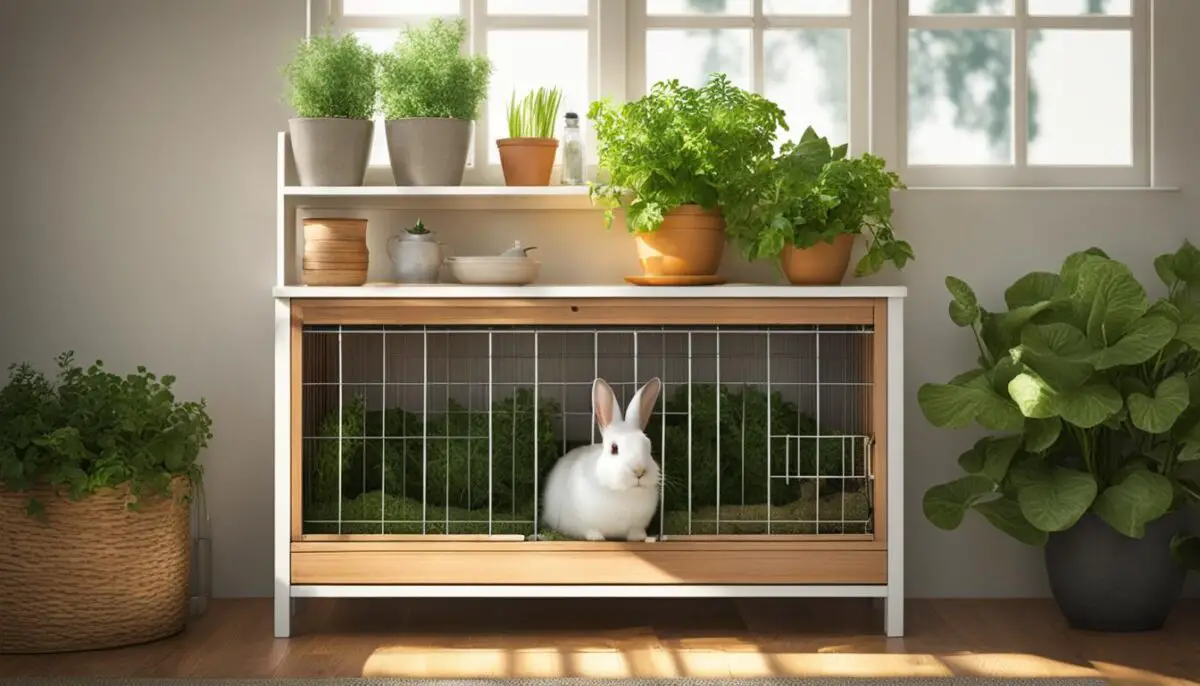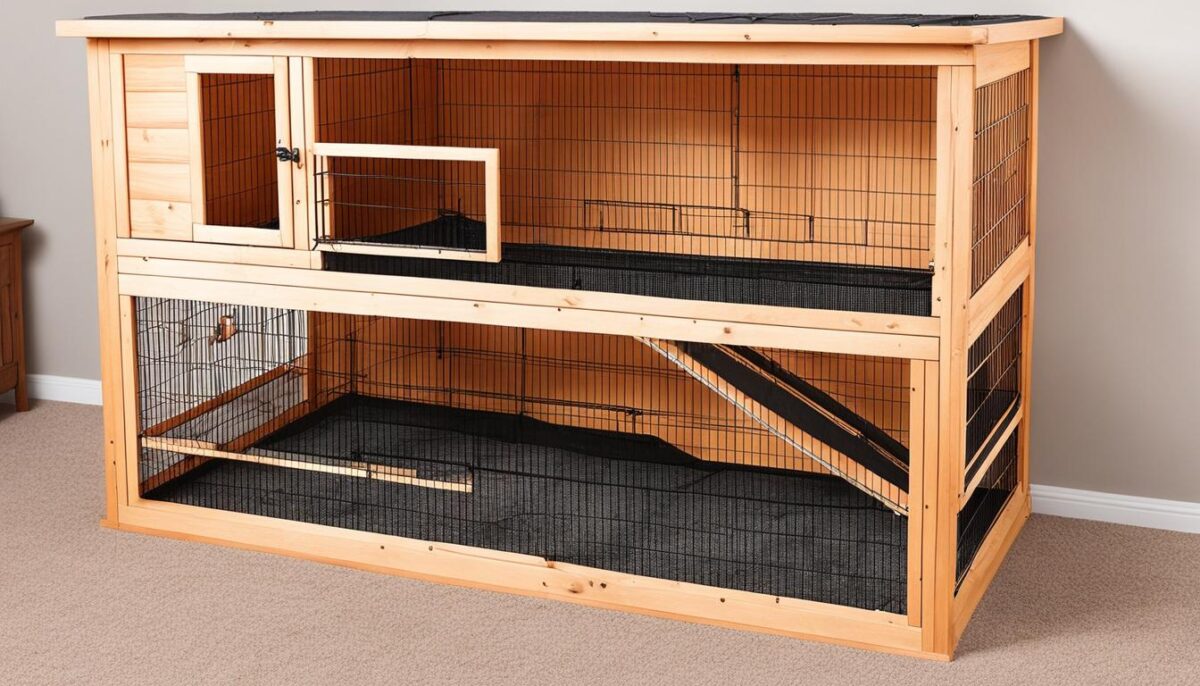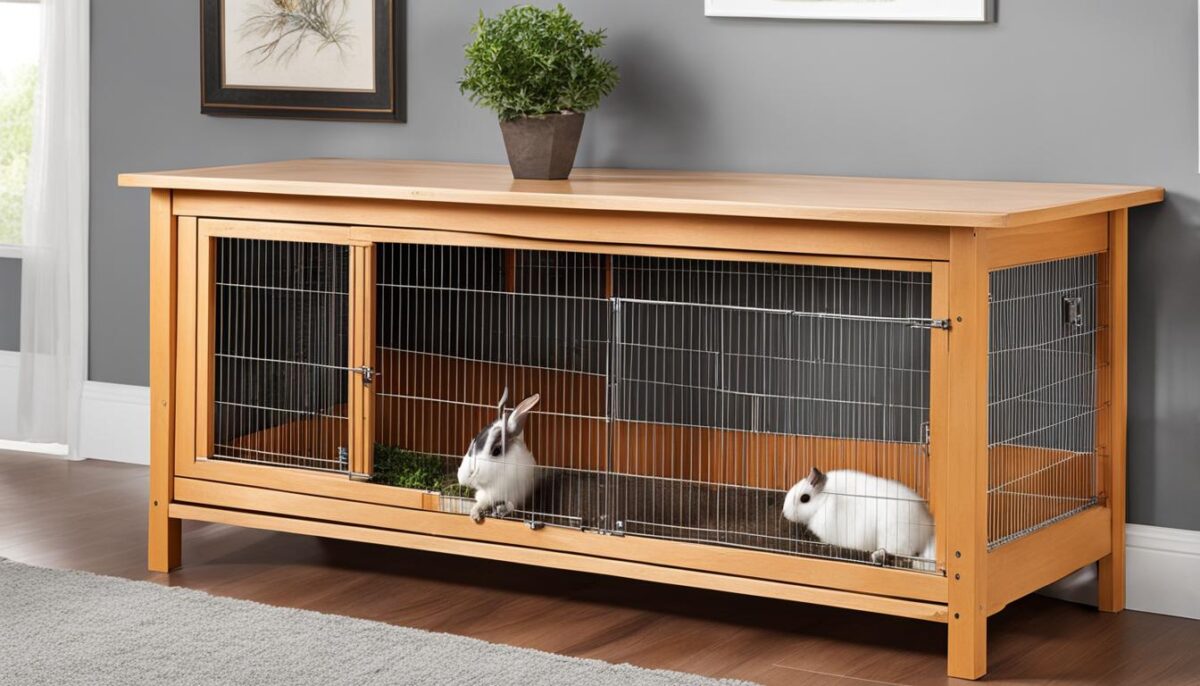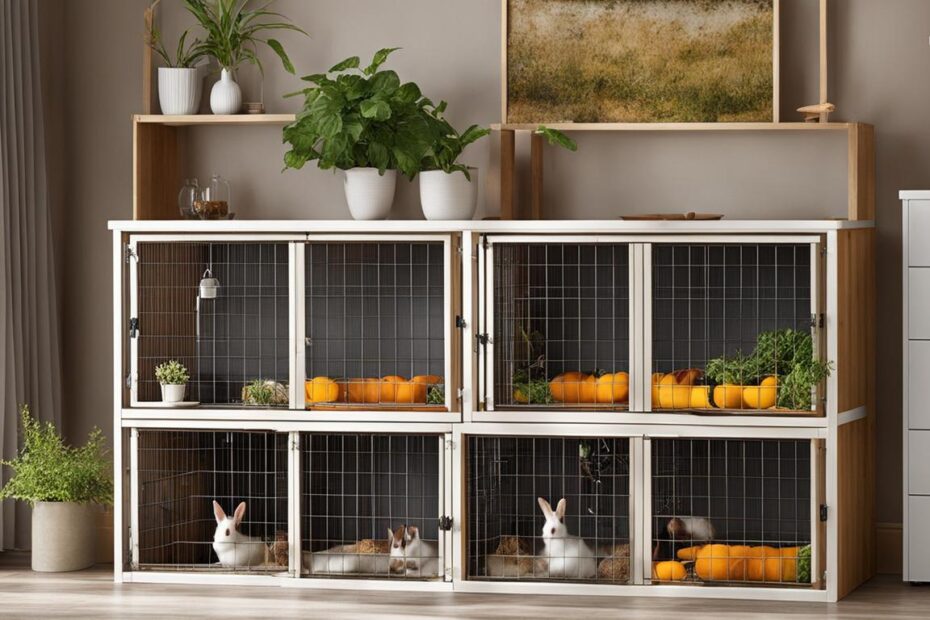Keeping rabbits indoors is a recommended practice for their safety and well-being. By providing a suitable living space inside your home, you can ensure that your furry friends are protected from extreme weather conditions and potential predators. Indoor housing also allows for more quality time with your rabbits, fostering a stronger bond between you and your pets.
To create a comfortable and enriching environment for your indoor rabbits, there are several factors to consider. You need to provide proper nutrition, a designated toilet area, hiding spots, a sleeping area, non-slip flooring, ample space for movement and exercise, safe toys for enrichment, a clean environment, and the option for companionship with other rabbits.
Key Takeaways:
- Rabbits are best kept indoors for their safety and comfort.
- Indoor housing allows for more interaction and bonding with your rabbits.
- Consider providing a proper diet, a safe and clean living space, and opportunities for exercise and enrichment.
- Companionship with other rabbits can be beneficial for their well-being.
- Ensure the indoor rabbit hutch has non-slip flooring and appropriately sized hiding spots for their comfort.
Why You Should House Rabbits Indoors
Rabbits are vulnerable to extreme weather conditions when housed outdoors. Keeping them indoors ensures their safety and comfort. Indoor housing also allows for more interaction between rabbits and their owners, promoting a stronger bond. Indoor rabbit cages provide a safe and enriching environment for rabbits to exhibit natural behaviors like running, jumping, and hiding.
When rabbits are kept outdoors, they face numerous risks. Extreme temperatures and sudden weather changes can pose serious health threats to rabbits, leading to heatstroke, hypothermia, or other weather-related illnesses. Additionally, outdoor rabbits are exposed to potential predators like cats, dogs, foxes, or birds of prey. By housing rabbits indoors, you can protect them from these dangers and ensure their well-being.
Furthermore, keeping rabbits indoors allows for increased interaction and socialization with their owners. Rabbits are social animals and form strong bonds with humans. When housed inside, rabbits have more opportunities to spend time with their owners, building trust and strengthening their relationship. Regular handling, playtime, and cuddling sessions create a positive and loving environment, reducing stress and providing mental and emotional stimulation for rabbits.
Indoor rabbit cages provide a safe and enriching space for rabbits to explore and engage in natural behaviors. With proper housing, rabbits can run, jump, and frolic, simulating their natural environment. The cages can be customized with toys, tunnels, and ramps to create an interactive and stimulating habitat for rabbits. This allows them to stay physically active, mentally stimulated, and connected to their instincts.
Ultimately, housing your rabbits indoors not only ensures their safety, but also enhances their quality of life. It provides them with a secure and comfortable environment to thrive, while also strengthening the bond between you and your furry companions.

Choosing the Right Indoor Rabbit Cage
When it comes to providing a comfortable and safe living space for your indoor rabbits, choosing the right cage is crucial. Consider the material, size, and ease of cleaning to ensure your furry friends have a happy home.
Wire Cages
Wire cages are a popular choice for indoor rabbit housing. However, it’s important to note that many wire cages on the market are too small and can cause foot issues for rabbits. Make sure to select a wire cage that provides ample space for your rabbits to move around comfortably.
Plastic Cages
While plastic cages may seem convenient, they are not recommended for rabbits. These crafty creatures have a knack for chewing, and plastic cages are no match for their sharp teeth. Opting for a sturdier material will help prevent any escape attempts or potential health hazards.
Wooden Hutches
Wooden hutches are commonly used for outdoor rabbit housing, but they can be challenging to clean when used indoors. The porous nature of wood makes it more susceptible to urine and odors, which can be difficult to remove completely. Consider the maintenance aspect before deciding on a wooden hutch for an indoor setup.
Multi-Level Cages
To provide your rabbits with various hiding spots and nesting areas, consider investing in a multi-level cage with ramps. These types of cages offer vertical space for rabbits to explore and promote their natural behaviors. Remember to ensure the ramps are secure and slip-resistant to prevent any injuries.
C&C Cages
If you’re looking for a spacious and customizable option, C&C cages are worth considering. These cages are constructed using grids and a sturdy plastic base, allowing you to create a layout that suits your rabbits’ needs. C&C cages offer plenty of room for your rabbits to play, hop, and relax.
“Choosing the right indoor rabbit cage is essential for the well-being of your furry companions. Consider their comfort, safety, and the ease of maintenance when making your decision.”

Comparison of Indoor Rabbit Cage Options
| Indoor Rabbit Cage Type | Advantages | Disadvantages |
|---|---|---|
| Wire Cages | Allows for better ventilation Easy to observe the rabbits |
Potential foot issues for rabbits due to small spacing Less privacy |
| Plastic Cages | Easy to clean Can provide more privacy |
Rabbits can chew through the plastic Potential chemical hazards if not made from pet-safe materials |
| Wooden Hutches | Durable and suitable for outdoor use Can provide a natural aesthetic |
Challenging to clean Porous material may absorb urine and odors |
| Multi-Level Cages | Offer hiding spots and nesting areas Promote natural behaviors |
Requires secure and slip-resistant ramps May occupy more space in your home |
| C&C Cages | Spacious and customizable Easy to clean |
Requires assembly May not be readily available in all locations |
Size and Space Considerations for Rabbit Cages
Proper cage size is crucial for the well-being of your rabbit. Providing enough space allows them to exhibit natural behaviors and ensures their overall comfort. The minimum recommended cage size for a rabbit is 8-12 square feet, which allows for hopping, stretching, turning around, and rearing up on hind legs. However, larger cages are always better, especially for larger breeds that require more room to move around.
It’s important to note that rabbits also need daily exercise outside of their cages. As such, they should have access to a designated play area of at least 24 square feet. This space allows them to run, hop, and explore, which is essential for their physical and mental well-being.
When designing or choosing a rabbit cage, consider the following size and space considerations:
- Ensure the cage provides enough room for the rabbit to move freely and engage in natural behaviors.
- Consider the size of your rabbit and choose a cage that accommodates their growth and breed-specific needs.
- Provide ample vertical space to allow the rabbit to stand on hind legs without any constraints.
- Allow for additional hiding spots and toy placements within the cage to encourage mental stimulation.
Remember that a well-sized and spacious cage contributes significantly to your rabbit’s overall health and happiness. By providing them with adequate space for both resting and exercise, you can create a comfortable and enriching environment for your furry friend.

DIY Rabbit Hutch Plans
Building your own rabbit hutch allows you to create a customized and cost-effective housing solution for your furry friends. With a wide range of DIY rabbit hutch plans available online, you can choose from various designs that suit your needs and preferences. These plans offer features such as multiple levels, easy cleaning access, and interactive elements for the rabbits’ enrichment.
Whether you’re looking for a simple and straightforward structure or a more complex design, there’s a DIY rabbit hutch plan out there for you. These plans provide step-by-step instructions, materials lists, required tools, and estimated building time, making it easier for you to embark on your hutch-building project.
Materials and Tools
To build your own rabbit hutch, you’ll need materials such as plywood, wood frames, hardware cloth, and furniture feet. These materials are readily available at most home improvement stores, making it convenient for you to gather everything you need for your project.
The tools required for building a DIY rabbit hutch generally include a drill, screws, a saw, wire cutters, and measuring tools. Having these tools on hand will ensure smooth construction and allow you to create a sturdy and secure hutch for your rabbits.
Benefits of DIY Rabbit Hutch Plans
“Building your own rabbit hutch not only enables you to save money but also gives you the freedom to customize the design to best suit your rabbits’ needs. It allows you to create a unique and functional living space that provides comfort, enrichment, and security for your furry companions.”
Estimated Building Time
Depending on the complexity of the chosen plan, the estimated building time for a DIY rabbit hutch can vary. While simpler designs may take a few hours to complete, more intricate structures could require a weekend or longer to construct. It’s essential to set aside enough time and prioritize safety measures to ensure your rabbits’ future home is built with care.
Sample DIY Rabbit Hutch Plan
| Design | Features | Difficulty | Estimated Building Time |
|---|---|---|---|
| Two-Level Hutch | Multiple levels, ramps, removable trays for easy cleaning | Intermediate | Approximately 8-10 hours |
| Outdoor/Indoor Hutch Combo | Convertible design, weatherproof materials, predator-proof | Advanced | Approximately 2-3 days |
| Enrichment-Focused Hutch | Tunnels, hiding spots, elevated platforms, interactive toys | Advanced | Approximately 1 week |
Remember to carefully read and follow the instructions provided by the DIY rabbit hutch plan you choose. Take your time, measure accurately, and double-check your work as you progress through the construction process. By building your own rabbit hutch, you can create a safe, comfortable, and tailored home for your beloved rabbits.
Conclusion
Indoor rabbit housing is the ideal solution for providing a safe and comfortable environment for your furry companions. By keeping your rabbits indoors, you ensure their well-being and minimize the risks associated with outdoor housing. Additionally, housing your rabbits indoors allows for more interaction and bonding opportunities with you, their owner.
When choosing an indoor rabbit cage, it’s important to consider factors such as size, material, and safety features. Ensuring that the cage provides enough space for your rabbits to move freely and exhibit natural behaviors is crucial for their overall health and happiness. Selecting a cage made of durable, non-toxic materials will ensure the safety of your rabbits.
For those who enjoy DIY projects and want to save some money, DIY rabbit hutch plans are the way to go. These plans offer customization options to suit your specific needs and allow you to build a personalized indoor home for your rabbits. Whether you’re a beginner or an experienced builder, there are plans available for every skill level.
By following the tips and guidelines outlined in this guide, you’ll be able to create a happy and healthy indoor home for your furry rabbit companions. From choosing the right cage to building your own DIY hutch, you’ll provide your rabbits with a comfortable and secure living space that promotes their well-being and strengthens your bond.
FAQ
Why is it recommended to house rabbits indoors?
Keeping rabbits indoors provides protection from extreme weather conditions and potential predators. It also allows for more quality time and interaction with their owners.
What should be included in an indoor rabbit cage?
An indoor rabbit cage should include proper nutrition, a toilet area, hiding spots, a sleeping area, non-slip flooring, ample space for movement and exercise, safe toys for enrichment, a clean environment, and companionship with other rabbits.
What should I consider when choosing an indoor rabbit cage?
Factors to consider include the material, size, and ease of cleaning. Wire cages can be too small and cause foot issues, while plastic cages can be chewed through. Wooden hutches are suitable for outdoor use but may be challenging to clean. C&C cages made with grids and a sturdy plastic base offer spacious and customizable options.
How much space should a rabbit cage provide?
The minimum recommended space for a rabbit’s cage is 8-12 square feet, allowing for hopping, rearing up on hind legs, turning around, and stretching out fully. Larger cages are better, especially for larger breeds. Rabbits should also have access to an additional area of at least 24 square feet for play and exercise.
What materials are suitable for a rabbit cage?
Rabbit cages should be made of durable, non-toxic, and pet-safe materials. The flooring should be suitable for rabbits’ feet to prevent injuries. It’s important to choose a cage that is secure and protects the rabbit from larger pets like cats or dogs. Kavee offers rabbit cages with secure locking slot construction, comfortable flooring, customizable side doors, safe grid coating, and optional lids for added protection.
Can I build my own rabbit hutch?
Yes, building your own rabbit hutch allows for customization and cost-saving. There are various DIY rabbit hutch plans available online, ranging from basic structures to more complex designs. Plans provide step-by-step instructions, materials lists, tools required, and estimated building time.
What are the benefits of housing rabbits indoors?
Housing rabbits indoors provides a safe and comfortable environment, ensuring their well-being and promoting a stronger bond with their owners.


